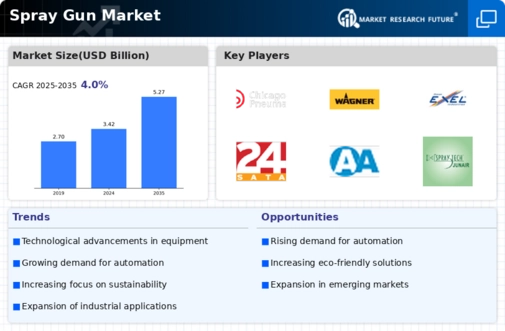Market Growth Projections
The Global Spray Gun Market Industry is projected to experience substantial growth over the coming years. In 2024, the market value is estimated at 3.42 USD Billion, with expectations to reach 5.27 USD Billion by 2035. This growth trajectory suggests a compound annual growth rate of 4.01% from 2025 to 2035, indicating a robust demand across various sectors. Factors contributing to this growth include advancements in technology, increasing applications in automotive and construction, and a rising awareness of environmental regulations. The market's expansion reflects the evolving needs of consumers and industries, positioning spray guns as essential tools in modern applications.
Expansion of Construction Activities
The Global Spray Gun Market Industry is significantly influenced by the expansion of construction activities worldwide. As urbanization accelerates, the demand for efficient painting solutions in residential and commercial projects increases. Spray guns offer advantages such as speed and uniform application, which are essential in large-scale construction. The projected growth of the construction sector is expected to bolster the spray gun market, with an anticipated market value of 5.27 USD Billion by 2035. This growth is indicative of the construction industry's reliance on advanced tools to meet the rising demand for quality finishes, thereby enhancing the overall market landscape.
Increasing Environmental Regulations
The Global Spray Gun Market Industry is also impacted by increasing environmental regulations aimed at reducing volatile organic compounds (VOCs) emissions. Governments worldwide are implementing stricter guidelines to promote eco-friendly practices in manufacturing and construction. As a result, there is a growing demand for spray guns that utilize water-based paints and low-VOC materials. This shift not only complies with regulations but also appeals to environmentally conscious consumers. Consequently, manufacturers are adapting their product lines to meet these standards, which is likely to enhance market growth as industries seek compliant and sustainable painting solutions.
Growing Demand for Automotive Applications
The Global Spray Gun Market Industry experiences a notable surge in demand driven by the automotive sector. As manufacturers increasingly adopt advanced painting technologies, the need for high-quality spray guns becomes paramount. In 2024, the market is projected to reach 3.42 USD Billion, reflecting the industry's response to evolving consumer preferences for aesthetically pleasing vehicles. Furthermore, the automotive industry's shift towards electric vehicles necessitates innovative painting solutions, thereby enhancing the market's growth prospects. This trend indicates a robust future for spray guns, particularly as the sector anticipates a compound annual growth rate of 4.01% from 2025 to 2035.
Rising DIY Culture and Home Improvement Trends
The Global Spray Gun Market Industry is witnessing a rise in demand fueled by the growing DIY culture and home improvement trends. As more individuals engage in home renovation projects, the need for user-friendly and efficient painting tools becomes apparent. Spray guns offer an accessible solution for homeowners seeking professional-quality finishes without the need for extensive training. This trend is particularly pronounced in regions experiencing economic growth, where disposable income allows for investment in home improvement. The increasing popularity of DIY projects is expected to contribute positively to market dynamics, further solidifying the role of spray guns in the consumer market.
Technological Advancements in Spray Gun Design
Technological advancements play a crucial role in shaping the Global Spray Gun Market Industry. Innovations such as improved nozzle designs and enhanced fluid delivery systems contribute to more efficient and precise application processes. These advancements not only reduce material waste but also improve the overall finish quality, appealing to various industries including automotive and construction. As manufacturers continue to invest in research and development, the market is likely to see an influx of new products that cater to specific user needs. This focus on innovation is expected to drive market growth, aligning with the projected CAGR of 4.01% from 2025 to 2035.
















